Stylistics
Stylistics
as a branch of linguistics science.
The
term stylistics is derived from the word “style”. The word
“style” goes back to the Latin word “stilos”. The Romans
called thus a sharp stick used for writing on wax tablets. Later on,
the meaning of this word came to denote not only the tool of writing,
but also the manner of writing.
Stylistics
is a branch of linguistics dealing with variants, varieties of
linguistic expressions and with subsystems of the language.
These
subsystems are created by extra lingual factors but at the same time
they have linguistic contents, that is they differ lingually from one
another. Being itself a system of signs, language may be subdivide
into parallel subsystems synonymous to one another.
Special
subsystem are made up by:
-
Neutral
type of linguistic intercourse -
Substandard
( Lying below the standard) type -
Super-standard
(high flown, solemn or official) type
The
ultimate aim of stylistics is to establish the objective laws and
practical rules of using proper linguistic forms in proper
situations.
Stylistics
in a broad sense is the investigation of synonymous linguistic means
for the purpose of finding out their spheres of applicability.
Stylistics
resembles the so-called dialectology. This branch of linguistics
studies territorial variants of the national language.
Stylistics
studies social variants of the language. Such variants are used by
the same person in different social situations.
Since
the subsystems used in different types of speech, may differ from one
another in every aspect – phonetically, lexically, morphologically,
syntactically and semantically – stylistics is connected with all
corresponding branches of linguistics and should be subdivided into
the following branches:
-
Stylistic
semasiology -
Stylistic
lexicology -
Stylistic
syntax -
Stylistic
phonetics
Stylistic
with all its subdivisions reveals a peculiar approach to the
language. It comprises the subsystems to find out the so-called
styles. Every type of speech uses its own lingual subsystems: not all
the forms comprising the national language, but only a certain number
of forms. Every subsystem consists of:
-
Linguistic
units common to all the subsystems -
Specific
linguistic units to be found only in the given subsystem
Every
linguistic unit along with the meaning has its stylistic value which
may be characterized as connotation (additional meaning)
The
connotation of a linguistic unit is just what we think of it
belonging either to the specific sphere of a certain subsystem or to
the non-specific sphere common to all the subsystems. So, stylistic
value is actualized by means of associations namely:
-
Linguistic
units that are used everywhere cause no definite associations with
any peculiar type of speech. Thus they have no stylistic value and
are called stylistically neutral -
Linguistic
units belonging to the specific sphere of a subsystem are mentally
associated with that sphere. They are stylistically colored.
Stylistic
semasiology is a part of stylistic which investigates stylistics
phenomena in the sphere of semantics regardless of the form of
linguistic units.
Non-stylistic
semasiology studies meanings. Stylistic semasiology studies rules and
laws of shifts of meanings, the patterns according to which meanings
are shifted or various combinations producing a certain effect.
Stylistic
semasiology also studies stylistic functions of shifts of meanings
and of certain combinations of meanings.
Stylistic
phenomena effected by various shifts of meanings are usually turned
figures of speech
Shifts
of meanings can be divided into 2 large groups:
-
There
are cases when the disparity of the actual denomination of the
referent with the usual, traditional denomination of it can be
understood as quantitative that is the referent is simply
exaggerated or underestimated. -
In some cases the disparity between the traditional and actual denomination is qualitative
Hence,
the corresponding figures of speech may be subdivided accordingly
into figures of quantity and the figures of quality. Both figures of
quantity and figures of quality may be called figures of replacement
since they are based on replacement of the habitual name of the thing
by its situational substitute.
We
can give the name of figures of co-occurrence to those stylistic
phenomena which are based on combination of meanings in speech. The
difference between the figures of replacement and those of
co-occurrence is as follows. In the form it is the one meaning that
produces stylistic effect, in the letter it is a combination of at
least 2 meanings that produces stylistic effect. Thus figures of
replacement are divided into figures of quality and the figures of
quantity. In their turn figures of quality are subdivided into
metonymical group (metonymy, synecdoche, periphrasis)- this is
transfer by contiguity. The second – metaphorical group –
transfer by similarity (metaphor, personification, epithet). Irony
are transferred by contrast.
Figures
of so-occurrence are divided into 3 groups
-
Figures
of identity, simile, synonymic repetition -
Figures
of inequality (gradation, anti-climax) -
Figures
of contrast (antithesis, oxymoron)
Figures
of replacement
-
Figures
of quantity-
Hyperbole
– is the use of a word, word group or a sentence which
exaggerates the real degree of a quantity of the thing spoken
about. It is a distortion of reality for the purpose of the
visualization or strengthening the emotional effect. It is also an
important expressive literally device often employed for humoristic
purposes. E.G. One after another those lay down on the grass to
laugh – and two on them died. -
Understatement
– is reducing the real quantity of the object of speech. The
psychological essence of understatement is more complicated than
that of hyperbole. The hero is expected to understand the intention
of discrepancy between what the speaker says about the object and
what he really thinks about it. E.G. I was half-afraid you’ve
forgotten me. -
Litotes
– is a specific variety of understatement consisting in
expressing lessened degree of quality of the thing by means of
negation of the antonym. The negation of the antonym expresses the
positive idea but in a somewhat-lessened degree. Not bad — in the
meaning of “good”. Little harm will be done by that.
-
-
Figures
of quality called tropes in traditional stylistics are based on the
transfer of names. We distinguish 3 types of transfer – by
contiguity, similarity, contrast.-
Transfer
by contiguity is based upon some real connection between the 2
notions: the one which is named and the one the name of which is
taken for the purpose. -
Transfer
by similarity is based on likeness or similarity of the 2 object.
Real connection liking completely. -
Transfer
by contrast is a use of words and expressions with the opposite
meanings – opposite to those meant.
-
Metonymic
group
Metonymy
proper –is applying the name of the object to another object in
some way connected with the first. There are difference between the
objects.
-
Source
of action instead of action.
-
Effect
instead of the cause. He (fish) desperately takes the death -
Characteristic
feature instead of the object itself. He was followed by a pair of
heavy boots. -
Symbol
instead of the object symbolized. Crown instead of king.
Synecdoche
– is a variety of metonymy. It consists in using the name of the
part to denote the whole or vice versa. To be a cognate between a
wolf and owl. And this examples “wolf” and “owl” stand for
wild beasts and birds.
Periphrases
– is in a way related to metonymy. It is the description of an
object instead of its name. E.G. Delia was studying under Rosenstock
– you know his repute as a disturber of the piano keys.
Metaphorical
group.
Metaphor
– is a transfer of the name of an object to another object on the
basis of similarity or likeness between the 2 objects. At the same
time there is no real connection between them. As in the case of
metonymy. The stylistic function of the metaphor is not the mere
nomination of the thing in question but rather it’s expressive
characterization. E.G. the machine sitting at the desk was no longer
a man; it was a busy New-York broker.
Metaphor
has no limitations. It can be a word, a phrase, any part of a
sentence or a sentence as a whole. Metaphors are either simple or
complex (prolonged). The simple elementary metaphor is that which has
no bearing at the context – it is a word, a phrase or a sentence. A
prolonged metaphor is a liberated in the series of image, logically
connected with one another, producing a general description of
character as seen, etc.
Personification
is a particular case of metaphor. It consists in attributing life and
mind to inanimate things. Besides the actual objects of nature or
obstructions of mind such as life, death and so on are personified.
Thus personification is ascribing human properties to lifeless
objects.
In
most cases personification is indicated by some formal signals. First
of all it is the use of personal pronouns “he” or “she” with
lifeless objects. It may also be achieved by the direct address by
the object and by the capitalized writing of the word, which
expresses the personified notion.
Allusion
is a brief reference to some literary or historical event commonly
known. The speaker or writer is not explicit about what he means, he
only mentions some details of what he thinks analogous in the fiction
or history to the topic discussed.
Antonomasia
is the use of the name of historical, literary, mythological or
biblical personage applied to a person whose characteristic features
resemble those of the well-known original.
Irony
is the transfer based upon the opposition of 2 notions. The notion
“named” and the notion “meant”. Irony is used with the aim of
critical evaluation of the things spoken about.
E.G.
What a noble illustration of the tender laws of this favorite country
– they let the paupers go to sleep.
In
oral speech irony is made prominent by emphatic intonation, mimic and
gesticulation. In writing the most typical sings are inverted commas
or italics.
Figures
of co-occurrence
-
Figures
of identity
Simile
– is an explicit statement concerning the similarity of 2 different
notions. The purpose of this confrontation of the names of 2
different objects is to characterize vividly 1 of the 2.
One
of the 2 co-occurring denominations is the name of the object really
spoken about. The other denomination is that of an object not
connected with the first in the objective reality but having certain
features in common with it. E.G. That fellow is like an old fox
The
existence of common features is always explicitly expressed in a
simile mostly by means of the words “as”, “like” and others
There
are 2 types of simile
-
The
common feature of the 2 objects is mentioned. E.G. He is as
beautiful as a weather cock -
The
common feature is not mentioned. The hearer is supposed to guess
what features the 2 objects have in common. E.G. My heart is like a
singing bird
Care
should be taken not to confuse simile and any sort of elementary
logical comparison. A simile deals with confrontation of 2 objects
belonging to radically different semantic spheres. A comparison deals
with 2 objects of the same semantic sphere.
E.G.
She can sin like a professional singer (logical)
She
sings like a nightingale (simile)
Synonymic
repetition is the use of synonyms denoting the same object of reality
and occurring in the given segment of text.
We
distinguish:
-
Synonyms
of precision. 2 or more synonyms may follow one another to
characterize an object in a more precise way. The second synonym
expresses some additional feature of the notion. E.G. Joe was a
mild, good-natured, sweet-tempered, easy-going, foolish-fellow -
Synonymic
variations. Frequently synonyms or synonymic expressions are used
instead of the repetition of the same word or the same expression to
avoid the monotonousness of speech as excessive repetition of the
same word make the style poor. E.G. He brought some numberless
prizes. He told his mother countless stories every night about his
school competitions.
Соседние файлы в предмете [НЕСОРТИРОВАННОЕ]
- #
- #
- #
- #
- #
- #
- #
- #
- #
- #
- #
Слайд 1
Описание слайда:
Stylistics as a science
Prepared: Erzhanova K.,
Shakenova A.
Слайд 2
Описание слайда:
Stylistics is a branch of general linguistics. The term stylistics is derived from the word «style». The word style goes back to the Latin word «stilos». The Romans called thus a sharp stick used for writing on wax tablets.
Stylistics is a branch of general linguistics. The term stylistics is derived from the word «style». The word style goes back to the Latin word «stilos». The Romans called thus a sharp stick used for writing on wax tablets.
Слайд 3
Описание слайда:
Stylistics is a branch of linguistics dealing with variants, variants of linguistic expression and, hence, with the sub-systems making up the general system of language.
Stylistics is a branch of linguistics dealing with variants, variants of linguistic expression and, hence, with the sub-systems making up the general system of language.
Слайд 4
Описание слайда:
Stylistics is connected with phonetics, lexicology, morphology, syntax and semasiology. Since stylistics is interested in all the aspects of language, it is subdivided by different linguists into the same branches as linguistics in general: stylistic semasiology, stylistic lexicology, stylistic morphology, stylistic syntax, stylistic phonetics.
Stylistics is connected with phonetics, lexicology, morphology, syntax and semasiology. Since stylistics is interested in all the aspects of language, it is subdivided by different linguists into the same branches as linguistics in general: stylistic semasiology, stylistic lexicology, stylistic morphology, stylistic syntax, stylistic phonetics.
Слайд 5
Описание слайда:
Stylistic semasiologyis a part of stylistics which investigates stylistic phenomena in the sphere of semantics, i.e. in the sphere of meanings, regardless of the form of linguistic units.
Stylistic semasiologyis a part of stylistics which investigates stylistic phenomena in the sphere of semantics, i.e. in the sphere of meanings, regardless of the form of linguistic units.
Слайд 6
Описание слайда:
Stylistic lexicologystudies the semantic structure of the word and the interrelation
Stylistic lexicologystudies the semantic structure of the word and the interrelation
Stylistic morphologyis interested in the stylistic potentials of specific grammatical forms and categories, such as the number of the noun, or the peculiar use of tense forms of the verb, etc.
Слайд 7
Описание слайда:
СТИЛИСТИЧЕСКИЙ СИНТАКСИС
Stylistic syntaxis one of the oldest branches of stylistics that grew out of classical rhetoric. Stylistic syntax has to do with the expressive order of words, types of syntax links, figures of speech.
Слайд 8
Описание слайда:
Stylistic phonetics (or phonostylistics)is engaged in the study of style-forming phonetic features of the text. It describes the prosodic (relating to intonation) features of prose and poetry andvariants of pronunciation in different types of speech (colloquial or oratory or recital).
Stylistic phonetics (or phonostylistics)is engaged in the study of style-forming phonetic features of the text. It describes the prosodic (relating to intonation) features of prose and poetry andvariants of pronunciation in different types of speech (colloquial or oratory or recital).
General notes on style. The word is applied to so many situations and contexts that it becomes vague and obscure. People talk about an individual manner of using the language, the ability to write compositions and etc. Here are some definitions of style:
Style is the man himself (Buffon)
Style is depth (Darbyshire)
Style is choice
Style is a quality of language which communicates precisely emotions or thoughts, or system of emotions or thoughts, peculiar to the author (J.MiddletonMurray)
Слайд 9
STYLISTICS AS A
BRANCH OF LINGUISTICS:GENERAL CONSIDERATIONS
1) The subject of stylistics
2) Problems of stylistic research
3) Types of research and branches of stylistics
4) The concept of norm and its variants
5) Individual study
6) The concept of functional styles
Units of language on different levels are
studied by traditional branches of linguistics such as phonetics that deals
with speech sounds and intonation; lexicology that treats words, their meaning
and vocabulary structure, grammar that analyzes forms of words and their
function in a sentence which is studied by syntax. These areas of linguistic study
are rather clearly defined and have a long-term tradition of regarding language
phenomena from a level-oriented point of view. Thus, the subject matter and the
material under study of these linguistic disciplines are more or less
clear-cut.
It gets more complicated when we talk about
stylistics. Some scholars claim that it is a comparatively new branch of
linguistics which has only several decades of intense linguistic interest
behind it. Actually, the term stylistics came into existence not so long ago.
Thus, stylistics or as it is often called
linguo-stylistics is on the list of the youngest sciences. This branch of
linguistic came into active functioning in the middle of the 20th century. At
that period of time one could observe a serious decline in structural
linguistics when grammar failed to explain some linguistic phenomena. So,
stylistics came in.
As a matter of fact the problems of style and
the object of stylistics go as far back
as to ancient schools of rhetoric and poetics.
In ancient times rhetoric appeared as an
oratorical science. It was aimed at solving practical tasks – to teach people
how to express their thoughts skillfully. Ancient Greeks stated that
elaborately combined language means really possessed strong power of persuasion
and they appealed to embellish human speech by all possible language resources.
Actually, the word stylistics is derived from
the Latin word stylus/stilus – which means a slender-pointed writing
instrument (or a small stick with a
pointed end) used by both Romans and Greeks for scratching letters on
wax-covered plates/tablets.
In the course of time this word acquired several
meanings, each of these meanings can be applied to a specific study of language
areas and their use in speech.
It will not be an exaggeration to say that among
various branches of linguistics, the most obscure in content is undoubtedly
stylistics. It happens due to a number of reasons.
First of all, we should bear in mind that there
is a confusion between the terms “style” and “stylistics”. The concept of
“style’ is really broad and it is difficult to regards it as a term. The word
style today is used in its reference to completely different spheres of human
activity. We can speak of style in architecture (gothic, classical, barocco,
neo-classical); style in literature (naturalism, sentimentalism, realism); art
(surrealism, classicism, realism); behavior (eccentric; reserved; outspoken);
fashion (casual; classical);
In the given context style is viewed as a mode
of doing something.
We can say that the scope of problems in
stylistics is open to discussion up to the present day. In linguistics the word
style is used so widely that it requires some interpretation.
Out of different approaches as to the fields of
investigation, the most representative was worked out by professor I. Galperin
who singled out its leading aspects.
1)
The aesthetic
function of the language;
2)
Expressive means of
the language;
3)
Synonymous ways of
expressing one and the same idea;
4)
Emotional colouring
in language;
5)
A system of special
devices – called SDs;
6)
The splitting of a
literary language into separate systems – called styles;
7)
The interaction
between language and thought;

The individual manner
of an author in making use of language (individual study).
Practically all of
these statements have a certain bearing on the subject. Let’s examine them one
by one.
1) The Aesthetic function of the language is an
immanent part of works of art – poetry, imaginative prose – but one can’t
observe it in the works of science, diplomatic and business documents and other
types of texts. Thus, the definition covers only a limited part of the problems
of stylistics.
2) Expressive means are more typical of the
language of poetry, fiction, oratory, colloquial speech rather than the
language of science, technology, commercial documents.
3) Synonymous ways of expressing one and the same
idea is a doubtful statement as with the change of wording — a change of
meaning inevitably takes place – no matter how slight this change is.
4) The emotional colouring of words and sentences
is partially accepted as there are many types of texts that seem to be
unemotional but still subject to stylistic investigation.
5) A system of special devices – called SDs – is
also questionable as no work of art, no text, no speech consists of a system of
SDs. At the same time we can’t deny the fact that the style of anything is
formed by the combination of features, peculiar to it.
6) The splitting of a literary language into
separate systems – called styles. The given aspect also requires some
corrections. As any national language contains a great variety of sublanguages
or sub-standard types of speech – slang, barbarisms, vulgarisms, taboo and a
number of other – reflecting a fleeting character of language development. The
same concerns the problem of nomenclature of styles – in general.
7) The
interaction between language and thought. Thought and its lingual expression
make an inseparable unity, though a real intention may be different from what a
person says. At the same time the idea can be misinterpreted. Moreover, in case
form is changed – a change in content can be observed accordingly.

of language (individual study). The given thesis can be partly accepted as
individual analysis is based on the principle of generalizations.
Thus, none
of the given entries can be entirely acceptable.
The most
representative definitions of style were introduced from the 50-tieth to the
90-iethof the 20th century.
In 1955 the
academician V Vinogradov defined style as a “socially recognized and functionally
conditioned, internally united totality of the ways of using, selecting and
combining the means of lingual
intercourse in the sphere of national language”.
Prof. I. Galperin
offered his definition of style as “a system of interrelated language means
which serves a definite aim in communication”.
According to prof.
Y.I. Screbnev style is what differentiates a group of homogeneous texts (an individual text) from all other groups
(other texts).
Such researchers as
Riesel E., Brandes M.P., Stepanov Y.S., Piotrovsky R.S., Dolinin K.A., Arnold
I.V., Maltsev V.A., Kukharenko V.A., Morokhovsky P.N., Kozhina M.N., Golub I.B.
propose more or less analogous systems of styles based on the subdivision of styles
into 2 classes: literary and colloquial.
Different approaches to the phenomenon of style were
outlined by the representatives of foreign linguistic thought.
The set of rules how to write a composition –
sometimes style is associated with very simple notions like “style is the man
himself (Buffon 18thc.)
“Style – is depth,” said Darbyshire in 1971 “A Grammar
of Style”;
“style is deviation”- considered Enkvist in his book
Linguistic Stylistics published in the Hague in 1973.
All these definitions deal somehow with the essence of
style that is summed up by the following
observations:
Style is a quality of language which communicates
precisely emotions or thoughts or a system of them peculiar to the author
A true idiosyncrasy of style is the result of an
author’s success in compelling language to conform to his mode of experience
(Middleton Murry)
Style is a contextually restricted linguistic
variation (Enkvist)
Style is a selection of non-distinctive features of language(Bloomfield)
Style is simply synonymous with form or expression (Benedetto
Croce)
Archibald Hill states “structures, sequences and patterns which extend or
may extend beyond the boundaries of individual sentences define style”.
The most frequently met definition of style belongs to Seymour Chatman:
“Style – is a product of individual choices and the patterns of choices among
linguistic possibilities”.
Werner Winter continues this idea by claiming that the style may be
characterized by a pattern of recurrent selections from the inventory of
optional features of a language.
A famous French
linguist Ch. Bally claimed that stylistics is primarily the study of various
language resources of human emotions and that each stylistic form is marked
either by expressivity and emotivity.
The term style is
also applied to the teaching how to
write clearly, simply and emotionally to achieve correctness in writing and
avoid ambiguity.
From the practical
point of view stylistics is a science which provides a guide and recommendations
aimed at ensuring that speech is not only correct and precise, clear but at the
same time expressive and addressed not only to the hearer’s intellect but to
his feelings as well.
This practical
emphasis in stylistics presupposes the
existence of some definite norms that have taken shape as a result of selection from the whole range of language
means of definite patterns recognized by the majority of native speakers as the
most suitable for a particular situation of verbal communication.
THE CONCEPT OF NORM
The problem of
linguistic norm, including among others stylistic norm arises from the
immediate essence of language in use.
It is quite evident that in any literary
language norm is regarded as the invariant of phonetic, morphological, lexical,
syntactical patterns in circulation during a given period in the development of
the given language.
On the one hand – a
norm must possess a definite degree of stability so as to provide a firm basis
for its functioning without which no norm could exist.
On the other hand –
the linguistic norm is inevitably subject to change a various periods of the
evolution of a language, since language is a social phenomenon.
Variants of these
patterns may sometimes diverge from the invariant but never sufficient to become
unrecognizable or misleading.
The development of
any literary language shows that variants will always center around invariant
forms.
The concept of
linguistic norm is very complex. The flexibility of the linguistic norm results
in the situation where there may exist 2 equally valid variants of expression for 1 and the same language
phenomenon, both of which are accepted as correct. So, there may appear such a
situation when the old norm still exists as it hasn’t yet fallen into disuse and
a new one appears – though it has not yet fully asserted itself.
Thus, we can assume that variants appear all
the time, enriching the language to the
degree which no artificial language will ever be able to reach.
The norm of the
literary language will always presuppose vacillations from the received
standard. The problem is to establish the range of permissible vacillations
from the norm.
It is a constant
process of gradual change observed in the forms and meanings of the language
forms at a given period. And it is therefore very important to understand the
received standard of the given period of the language development in order to
comprehend the direction of further process.
To sum up, we can
conclude that variant as the term itself
suggests will never detach itself from the invariant to such a degree as to
claim entire independence. Yet, there is a tendency to estimate the value of
the individual style by the degree it violates the norms of the language.
INDIVIDUAL STYLE STUDY
Problems concerning
the choice of the most appropriate language means and their organization into a
message from the viewpoint of the addresser are in the centre of attention of the individual
style study.
The message is the common ground for communicants in an act of
communication, in the exchange of information between two participants of the
communicative act –
the addresser (the supplier of information, the speaker, the writer) and
the addressee (the receiver of the information, the listener, the reader).
The individual style study puts particular emphasis on the study of an
individual author’s style, it looks for correlations between the creative
concepts of the author and the language of his works.
In terms of information theory the author’s stylistics may be termed as
the stylistics of the encoder. In this case he tries to encode the information
and the supplier of the information, the addresser as the encoder. His
immediate task is to decode the information – to understand the message ad all
the implications and the problems connected with the adequate reception of the
message (without any informational losses or deformations, i.e. with adequate
decoding — the concern of decoding stylistics.
Слайд 1Prepared: Erzhanova K.,
Shakenova A.
Stylistics as a science
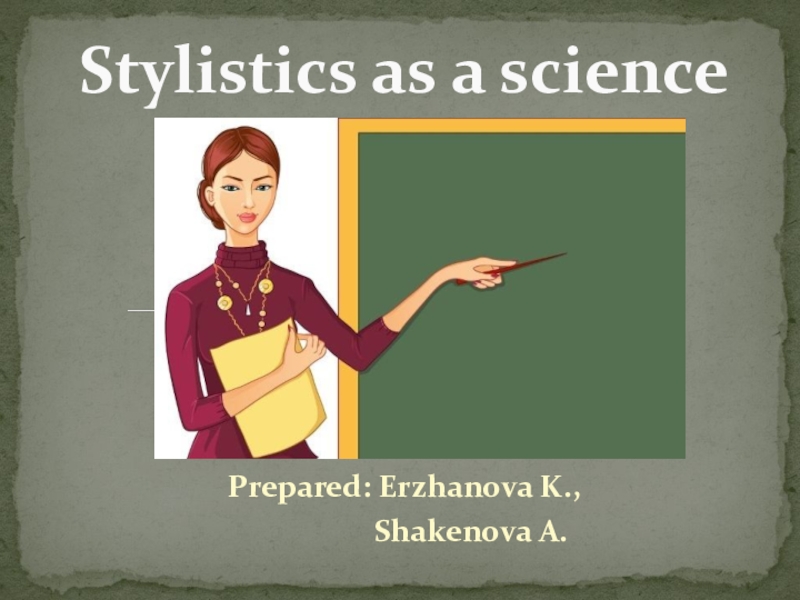
Слайд 2Stylistics is a branch of general linguistics. The term stylistics
is derived from the word «style». The word style goes
back to the Latin word «stilos». The Romans called thus a sharp stick used for writing on wax tablets.
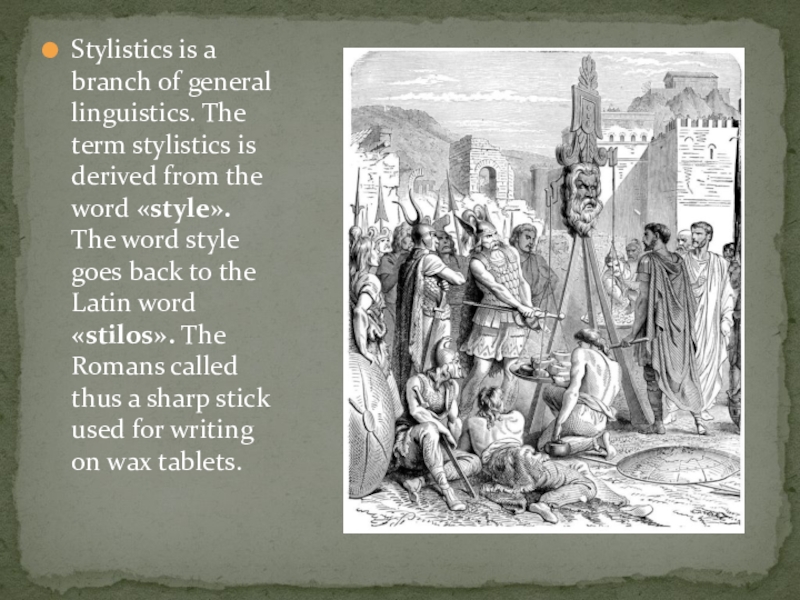
Слайд 3Stylistics is a branch of linguistics dealing with variants, variants
of linguistic expression and, hence, with the sub-systems making up
the general system of language.
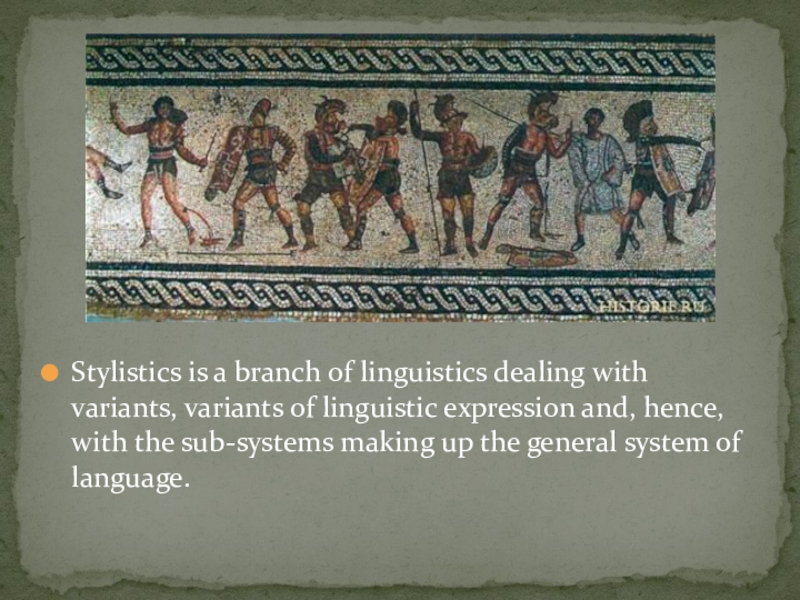
Слайд 4Stylistics is connected with phonetics, lexicology, morphology, syntax and semasiology.
Since stylistics is interested in all the aspects of language,
it is subdivided by different linguists into the same branches as linguistics in general: stylistic semasiology, stylistic lexicology, stylistic morphology, stylistic syntax, stylistic phonetics.
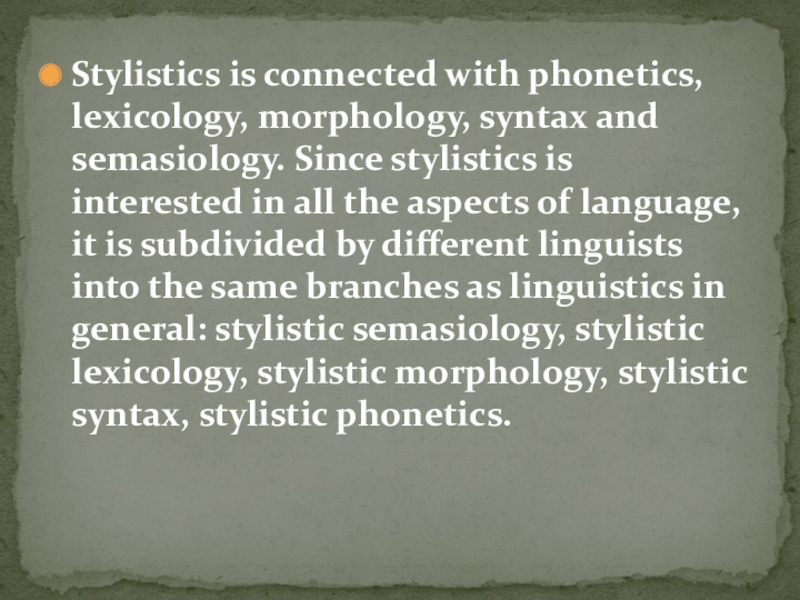
Слайд 5Stylistic semasiologyis a part of stylistics which investigates stylistic phenomena
in the sphere of semantics, i.e. in the sphere of
meanings, regardless of the form of linguistic units.
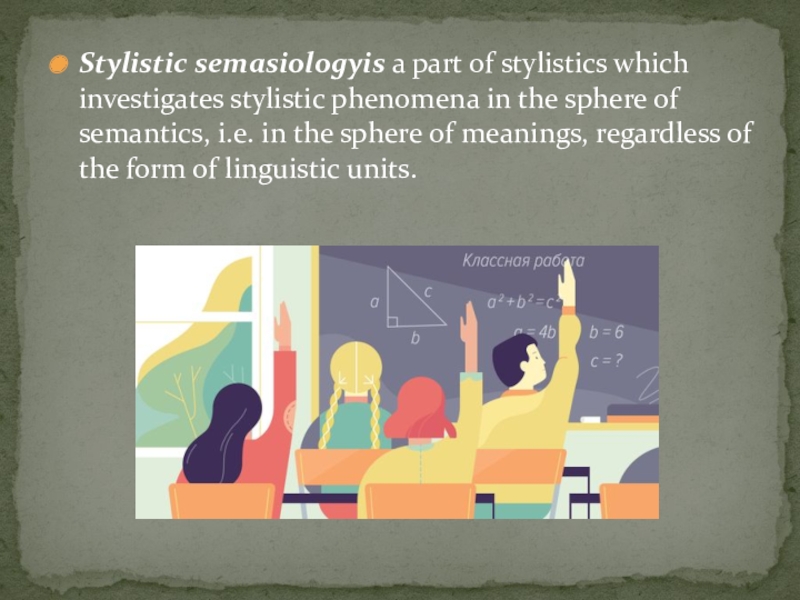
Слайд 6Stylistic lexicologystudies the semantic structure of the word and the
interrelation
Stylistic morphologyis interested in the stylistic potentials of specific grammatical
forms and categories, such as the number of the noun, or the peculiar use of tense forms of the verb, etc.
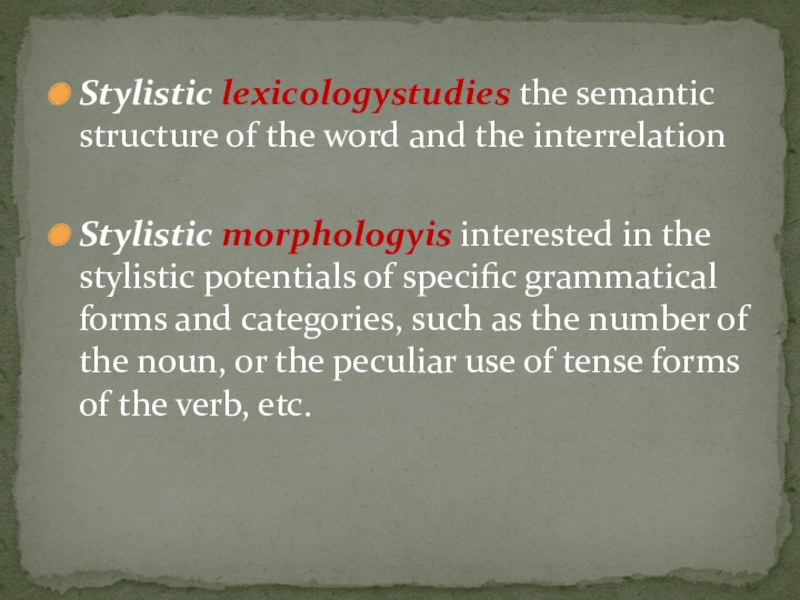
Слайд 7Stylistic syntaxis one of the oldest branches of stylistics that
grew out of classical rhetoric. Stylistic syntax has to do
with the expressive order of words, types of syntax links, figures of speech.
СТИЛИСТИЧЕСКИЙ СИНТАКСИС
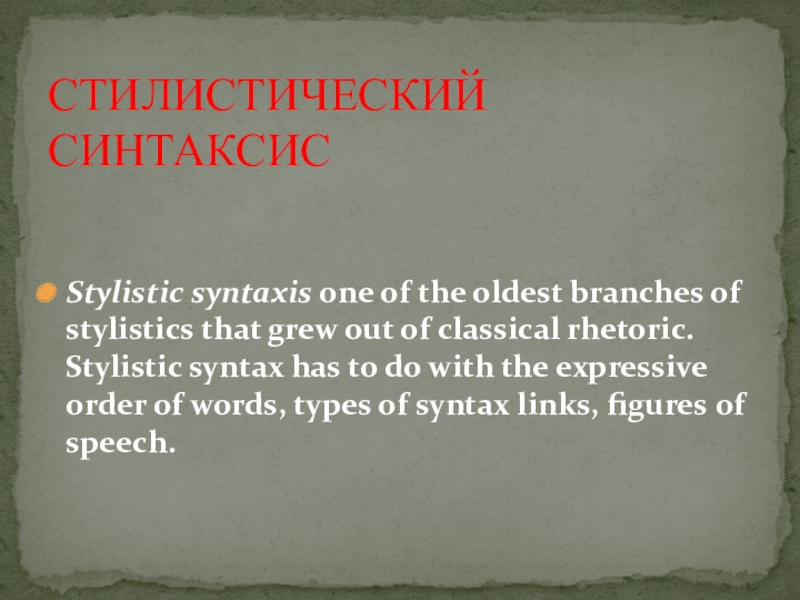
Слайд 8Stylistic phonetics (or phonostylistics)is engaged in the study of style-forming
phonetic features of the text. It describes the prosodic (relating
to intonation) features of prose and poetry andvariants of pronunciation in different types of speech (colloquial or oratory or recital).
General notes on style. The word is applied to so many situations and contexts that it becomes vague and obscure. People talk about an individual manner of using the language, the ability to write compositions and etc. Here are some definitions of style:
Style is the man himself (Buffon)
Style is depth (Darbyshire)
Style is choice
Style is a quality of language which communicates precisely emotions or thoughts, or system of emotions or thoughts, peculiar to the author (J.MiddletonMurray)
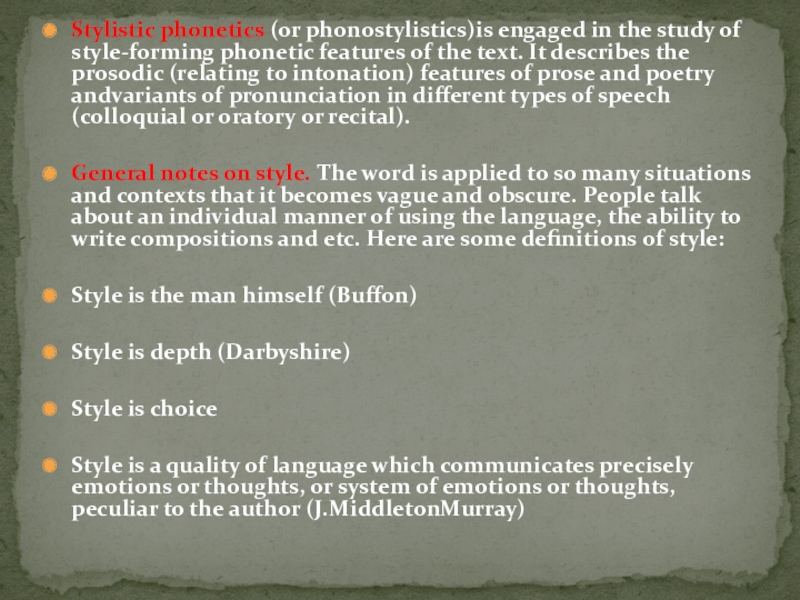
1. Stylistics as a science
Prepared: Erzhanova K.,
Shakenova A.
2.
Stylistics is a
branch of general
linguistics. The
term stylistics is
derived from the
word «style».
The word style
goes back to the
Latin word
«stilos». The
Romans called
thus a sharp stick
used for writing
on wax tablets.
3.
Stylistics is a branch of linguistics dealing with
variants, variants of linguistic expression and, hence,
with the sub-systems making up the general system of
language.
4.
Stylistics is connected with phonetics,
lexicology, morphology, syntax and
semasiology. Since stylistics is
interested in all the aspects of language,
it is subdivided by different linguists
into the same branches as linguistics in
general: stylistic semasiology, stylistic
lexicology, stylistic morphology, stylistic
syntax, stylistic phonetics.
5.
Stylistic semasiologyis a part of stylistics which
investigates stylistic phenomena in the sphere of
semantics, i.e. in the sphere of meanings, regardless of
the form of linguistic units.
6.
Stylistic lexicologystudies the semantic
structure of the word and the interrelation
Stylistic morphologyis interested in the
stylistic potentials of specific grammatical
forms and categories, such as the number of
the noun, or the peculiar use of tense forms
of the verb, etc.
7. СТИЛИСТИЧЕСКИЙ СИНТАКСИС
Stylistic syntaxis one of the oldest branches of
stylistics that grew out of classical rhetoric.
Stylistic syntax has to do with the expressive
order of words, types of syntax links, figures of
speech.
8.
Stylistic phonetics (or phonostylistics)is engaged in the study of
style-forming phonetic features of the text. It describes the
prosodic (relating to intonation) features of prose and poetry
andvariants of pronunciation in different types of speech
(colloquial or oratory or recital).
General notes on style. The word is applied to so many situations
and contexts that it becomes vague and obscure. People talk
about an individual manner of using the language, the ability to
write compositions and etc. Here are some definitions of style:
Style is the man himself (Buffon)
Style is depth (Darbyshire)
Style is choice
Style is a quality of language which communicates precisely
emotions or thoughts, or system of emotions or thoughts,
peculiar to the author (J.MiddletonMurray)









